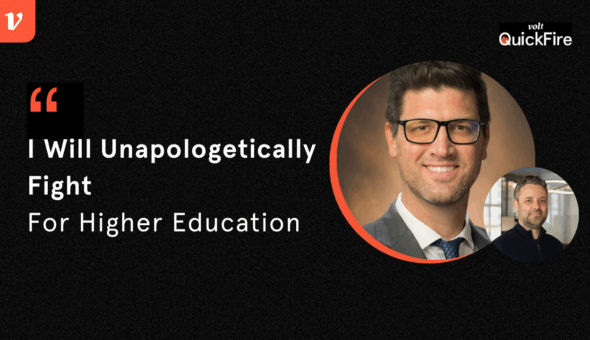Creating a blog for your university or college is a no-brainer; blogs are an essential part of any school’s content marketing strategy. Coming up with content on a weekly or daily basis for that blog, however, is another matter. The cyclical nature of higher education is a blessing and a curse; it can make it easier to plan content around the calendar year and upcoming annual deadlines, but it can also leave blog editors struggling for fresh ideas, especially if their blog is more established.
With that in mind, we’ve come up with 75 blog ideas for your university or college blog. For added convenience, we’ve organized these content ideas into four categories based on the suggested author of each blog post: current students, alumni, faculty and admissions professionals. We’ve also included a fifth bonus category, which contains content from other author groups, such as your enrolled students, career services office and more.
Jump to Section:
- From or Featuring Your Current Students: Student Life
- From or Featuring Your Current Students: Advice for Prospective Students
- From or Featuring Your Current Students: Campus Living
- From or Featuring Alumni
- From or Featuring Faculty
- From Your Admissions Staff
- Bonus Category: College Campus Potpourri
Category 1: From or Featuring Your Current Students
Subgroup A: Student Life
1. Check-ins from Summer and Semester Internships
We all know going to college is about more than going to class. Talk to your career services office to get a few recommendations on students with interesting internship placements, and then ask them to write about those periodically throughout the summer or after the internships finish and they’ve had a chance to reflect. This could also be a chance to build relationships with those companies that provide internships to start a pipeline between your college and companies from all industries.
2. Recaps of Student Events on Campus
Some colleges host “midnight madness” events. These are often student events that start at—you guessed it—midnight and help kick off the start of basketball season. Don’t let these events go private. They’re excellent content opportunities that go beyond a simple social media post or residence hall announcement.
3. Coolest Work-Study Jobs on Campus
Princeton University has perfected this idea. Work-study jobs are a necessary part of campus life for many students. I love the concept of taking something that isn’t traditionally a selling point and making it one. Well done, Princeton.
4. Spotify Playlists
Duke University initially expanded the scope of what was considered “content” with their Spotify playlists showcasing their students’ interests. When considering this idea, be sure to make different playlists for studying, homecoming, graduation, and so on.
Purdue University took this concept and turned it into a way students could collaborate and make public playlists together during the pandemic, going above and beyond what any Zoom classroom could do for an in-person community feeling.

5. Best Study Spots on Campus
This concept works because it’s technically a blog post for current students, which expands its reach, but it’s a sneaky way to showcase your campus and its buildings. Pro tip: consider posting the photos of the study spots on Pinterest, and then embedding the Pinterest board into the blog post.
If you want your students to get a better look at the community around them, take a page from UT Austin and include a few off-campus study spots, such as coffee shops and bookstores.
6. School Project Highlights
Initially used by the University of New Mexico, this idea is taking off with art schools and STEM programs. Your students are doing incredible things on campus; tap into that and share those projects with the world.
Not sure how to find these content opportunities? Consider creating an avenue for faculty to recommend projects for expanded coverage. You can even include faculty research in these highlights, as Towson University did, and use this as a way to get student talent into research opportunities with professors. It’s a win for all concerned.
7. Day in the Life
Your prospective students do care about this. You can find endless DITLO content on YouTube, like this video from a student at Wake Forest University. The key to success is to ask several different students to document their day-to-day. Remember, going the extra mile for popular college-oriented media students will not go unnoticed.
8. Sample Semester Schedule
Along the same line, give students a clear idea of what a sample semester course schedule may look like. When do students go to class? What do they do at night? Do students have classes on Friday? Consider asking students from different class years and different programs to write these posts, or even record a Q&A-style panel to turn long-written posts into condensed video posts instead.
9. Stories About Student Organizations
Prospective students want to get involved on campus. Showcase the different organizations they can join and document the exciting things those organizations are accomplishing. Colorado State University provides a good example of what something like this should look like: readable, easy to find and informative.
10. Experience with Studying Abroad
In 2020-21, the total number of U.S. students who studied abroad declined by 91%. The next year saw a renewed interest in international programs and a significantly greater number of U.S. undergrad students planning to study abroad. Cater to the undergrads that plan to study abroad and you’ll see the overall number of students who end up abroad increase as well.
11. Life as a Part-Time Student
For many schools, this is an ever-increasing subset of the student body. Part-time students are hard-pressed for time, but I’ve found that they are also more inclined to want to help out future part-time students by documenting their experiences. Fewer than one in five part-time students graduate within the traditional four-year term, so fostering a strong support system that understands everything they’re handling will be crucial in keeping them content and enrolled.
12. Life as a Night Student
If students who take night classes are an important audience for your institution, be sure to document any programs that might be helpful for these non-traditional students. Old Dominion University provides a solid example of creating something that documents university resources while maintaining a tone with which students can align.
13. Exploring ‘The Gap Year’
During the 2020-21 academic year, many students elected to take time off of school versus going fully remote, thus missing up to a full year of traditional in-person education. This isn’t likely going to apply to a large percentage of your audience, but if you cover the topic, you’ll make those few students feel seen.
SUBGROUP B: ADVICE FOR PROSPECTIVE STUDENTS
14. Advice for Move-In Day
Few events conjure up more mixed emotions than a move-in day. Feelings of excitement and anxiousness abound as students say goodbye to bedrooms and parents and hello to roommates and dorm rooms. Boost the excitement and quell the anxiousness by having current students share their best advice with incoming students. As mentioned in blog idea #7, countless examples of these are made by independent creators on YouTube, Twitter and Instagram.
15. How Students Chose Their Majors
You probably don’t need me to tell you this, but many prospective students don’t know what they are going to major in at college. Others pick majors but do so half-heartedly and later change their minds. This type of blog can help prospective students identify with current students, learn more about the majors your institution offers and learn about the process of choosing a major. Bonus point, it can also help you create a larger bullhorn for on-campus resources, such as a freshman advising staff and student development departments.
16. Advice/Experience of Being a Student Athlete
Employers love student-athletes because they’ve demonstrated that they can balance two full-time commitments while in school. Tap into their wisdom and set your future student-athletes up for success.
Incoming student-athletes can even be a target audience. Ohio University outlines simple habits and routines that can help prime incoming students for their upcoming busy college schedules.
17. What I Wrote About in My College Essay
Perhaps no aspect of the college application process is more feared than the college essay, and it will continue to be unless artificial intelligence makes this requirement obsolete. Have your admissions team mark some of their favorite essays and have those students talk about the thought process behind selecting their topics or what they hoped to accomplish in the essay. This can also help shed a little more light on what your admissions office wants to see out of their students, washing away some of the mystery and “crapshoot” mentality that many students face when sending their applications off to schools.
18. Student Success from the Waitlist
For some applicants, being waitlisted at their university of choice is almost worse than being rejected outright. That feeling of not being quite good enough can have lingering effects on the students who are ultimately granted admission. Find a successful student who was originally waitlisted and have them share their story. Note that this blog idea can be transferable to deferred applicants as well.
19. A Firsthand Account of the Admissions Interview Process
With the rise of virtual communication, such as Zoom and Cisco Webex, virtual interviews are now making college interviews significantly more available for colleges of varying selectivity in the United States. Although this type of content is useful from an admissions office viewpoint, getting a behind-the-scenes viewpoint from a current student may have a profound impact on your prospective students.
20. Remembering the Moment They Chose Your University
Find your current students who remember making their commitments and ask them to share how and why they chose your university. It’s just the type of emotional content that resonates with admitted students who are still on the fence. New York University shows us that this can be a great way to present content in both written and video formats.
21. Balancing Full-time Student Life While Employed Part-time
Let’s face it, outside work cuts into all aspects of a student’s life, socially and academically. Take a few students who are in this position and have them share their stories or day-to-day schedules. This will help students who are in the same position balance out their activities and provide a mini manual for collegiate success.
22. Letters Back to Themselves (During Their First Week) Written on Graduation Day
Now is the time to get graduating students to write letters to the version of themselves that first stepped foot on campus. Throwback social media and blog content are always entertaining, and your incoming students will gobble this up. You can see a version of this concept from the University of Pennsylvania’s Wharton School of Business.
23. What I Learned My Freshman Year of College
Continuing on the advice theme, incoming college students have plenty of questions about starting their academic careers on the right foot. Answer those questions with blog posts from successful upper-level students who can share advice for not just surviving, but thriving, as a freshman. Good outlets for these types of posts can be utilized through your college-backed websites or even social media platforms such as Reddit.
24. Packing List
Here’s another move-in day suggestion. No matter how much incoming students prep, they are bound to overlook something they’ll need for dorm life. Have your seasoned students create the ultimate packing list and get creative with how you share the information. For example, come up with an infographic or a checklist to post on platforms such as Twitter and Instagram.
25. Advice for First-Generation Students
This is pretty simple. Some incoming students have parents or siblings that they can lean on for college advice. Others don’t. Make sure you’re helping your incoming students in the latter category. Maybe take inspiration from Boston University and present this advice via digestible fast facts that anybody can look at for a few minutes and find key takeaways.

https://www.nyu.edu/admissions/undergraduate-admissions/why-i-chose-nyu.htmlSubgroup C: Campus Living
26. Dorm Room Tours
Prospective students, and their parents, want to see dorm rooms. Don’t just showcase the best rooms on campus either. Try to showcase dorm rooms in different buildings and students with different living arrangements. This is another great opportunity to add videos. SUNY Purchase even went the extra mile to include Google Earth-style room tours in which one can virtually walk around a variety of rooms at their own pace.
27. Dorm Room Decoration Inspiration
We all knew that friend in college who thought their dorm room was the best designed on campus. Find that student at your university and give them a platform to share advice on decorating dorm rooms with limited space. Not sure how to find this student? Consider hosting a contest where students can enter their rooms, like Texas Woman’s University’s “Best Nest Contest.” They’ll be more likely to participate than you think.
28. Dining Advice on Campus
Ask any admissions student ambassador about their most frequently asked questions, and I guarantee you that dining options are on the list. For some schools, this is pretty straightforward, but for others, this type of content could get pretty complex. If the latter describes your university, consider putting together a custom Google Map of dining options on or around campus. Brownie points if you put your custom dining map on platforms such as Snap Map and Instagram Map.
29. Advice for Getting Around Campus
When I arrived on campus for my freshman year, I was blown away by the number of students using longboards and skateboards to get around. I had no idea that was a thing. If you have a large campus, make sure you’re sharing what options are available for current students, from buses to the ubiquitous Bird Scooter: dockless electric scooters that you can find and rent with your smartphone app.
30. Tips for Living with Roommates
For many prospective students, college will be the first time they have shared a bedroom with another person, or group of people, in their life. Be sure to share best practices and advice from current students on sharing a living space, whether that’s with one student or several.
31. Living Off-Campus
During my senior year of college, almost everybody I knew lived in apartments and houses that were off-campus. If that’s true as well at your college or university, make sure to share the ins and outs of living in these independently owned buildings. New York University offers a great example of this and could be a big hit for your students, especially for colleges located primarily in the city.
32. Exploring the Surrounding Area
Whether students choose to live on or off campus, be sure to share information about the neighborhood beyond your university. This may involve the hottest restaurants and museums in a big city or where the local CVS or grocery store is located. Practical content can be incredibly helpful to an incoming student, who is going to be living in a new location for the next four or so years.
Category 2: From or Featuring Alumni
33. Career Advice
Your alumni have successfully navigated the transition from college student to professional, and they’ve certainly learned a thing or two along the way. Ask them to share that advice, whether it’s about job interviews, resumes or work–life balance. Linkedin can be a great method to show off these posts and even provide current students with the opportunity to connect with and speak to those alumni.
34. Career Highlights
Your prospective students are evaluating their potential career prospects. Identify some of your biggest alumni success stories and profile those individuals. In this win-win scenario, you earn appreciation from your alumni and demonstrate proof of success to your prospective students. Check out Villanova University’s use of LinkedIn to highlight its graduates and faculty.
35. Day with Alumni
Over the past two years, TikTok has taken the social media scene by storm. Our next idea comes from the University of Washington, utilizing this ultra-popular platform to showcase a day in the life of alumni. This offers a ton of creative opportunities, maybe even showcasing the post-grad lives of various majors. Be sure to check if your state or university is one of the many banning the platform before posting.
36. Oral Histories of Great Moments in University History
Oral histories are fascinating. I guarantee you that your university has a moment in its rich history that is beginning to be explored from new and diverse vantage points. Pick a moment and interview alumni, administrators and faculty about their memories from the event. This is a great way to put a new twist on documenting your university’s past.
37. What I’d Do Differently
Your alumni have learned a thing or two from transitioning from student to professional. Most alumni will be very willing to share those lessons, even if they learned them the hard way. Publishing content that’s humble humanizes your brand and resonates with all audiences.
38. #TBT Photos and the Story Behind Them
Throwback photos are always crowd-pleasers, especially for alumni. However, most universities just share photos of the quad or old buildings. Ask your alumni for fun pictures from their time on campus and share those images with the stories that explain the photo. Something that should be noted is that your school should coin its version of “#tbt” to stray away from this dated term. For example, Temple University could coin “#TempleTimeMachine” for its old photos and videos.
39. Why I Chose This University
This concept is pretty self-explanatory. The power behind asking your alumni to write the story is that it’s one thing to be happy with your college choice while you’re still a college student, but remaining satisfied with your choice of college years later says something entirely different. This is also a huge green flag if you’re trying to showcase your strong alumni network to potential students and parents.
40. Alumni Events Recaps
Consider publishing these posts during alumni events in different cities or around campus events like homecoming. This will boost your alumni presence and motivate other alumni to join up when events are held at a later date.
41. How I Used My College Network to Land a Job
This concept is especially relevant for graduate and professional schools. Your prospective students are coming to you for one reason: to better their careers. Make sure you’re demonstrating that others sought the same thing and succeeded using their college networks. You could also pick alumni with different majors, current cities and activities in college to highlight the different career paths students can model and pursue.
42. Advice for Reaching Out to Alumni
I have heard students share how they networked with an alum of the school to land coveted internships. Your students may love the idea of reaching out to alumni but may be too intimidated to do so. This type of post can help students overcome anxious feelings and create an environment in which alumni are looking for messages from current students. The University of Pennsylvania goes the extra mile and even includes email templates for its students to use when reaching out and connecting with alumni.
43. What I’m Looking for When Hiring New Graduates
Consider this idea as a large tree with many branches. What are employers looking for in cover letters, resumes and Linkedin or Handshake profiles? What are they looking for during interviews? What extracurricular activities do they hope to see? How about internships? How important are grades? The list goes on and on, with no limit to the available topics.

Category 3: From or Featuring Faculty
44. Faculty Research Topics and Their Impact in Layman Terms
You have three options when it comes to publishing content regarding faculty research. You can (1) not publish it, (2) publish it in its jargony glory or (3) share it in an interesting and tangible way that prospective students can understand. Follow Temple University’s lead and choose option 3.
45. Highlights of Specific Majors
We’ve covered the theme of choosing a college major a few times on this list, but I think having faculty members discuss the merits of different majors can be a good starting point for students who are still unsure.
46. What Faculty Love About Teaching
Faculty are too often stereotyped as research addicts who only teach as a requirement to the school. For many faculty, that’s just not the case. Give them a platform to talk about what they love about teaching and share that content with any prospective or admitted students in your database that are considering studying in that school or major. Your faculty are just as diverse as your student population, and you must remember that they chose your institution to pursue their passions.
47. How to Succeed in My Class
I could always count on my professors saying one thing that was the simplest, yet most pivotal, part of collegiate success: show up on time. Your faculty are probably clear about what it takes to succeed in their classes too. Don’t keep that information hidden from students until the first day of class.
48. Advice for Not Just Surviving But Thriving in Your First Semester
I included this topic above in the current student section of this blog post, but your faculty will have a much different vantage point on this than your students.

49. How They Came to Teach and Study Their Area of Focus
This type of content is all about humanizing your faculty members and helping students identify with them. When you publish this type of content, you build a connection between your prospective and current students and your faculty. This is a big part of a student’s decision to enroll in your university. The University of Rhode Island sets a great example as to what you should be looking for in these blog posts for your institution.
50. Ways to Get Involved with Undergraduate Research
This is a helpful blog post for current students but there is a secondary benefit to prospective students who have a clear picture of their plans once enrolled in your university. Make sure you target faculty members who are working on especially interesting projects to maximize the marketing impact of this content.
51. Get to Know the Dean
The University of Nebraska-Lincoln initially launched the incredible “Perls of Knowledge” video series in 2014. (Check out the original videos. They are comedy gold.) There are many different ways to put a creative spin on this if your university gives this blog idea a try. Check out Texas A&M’s post about their current dean of education and human development. These posts help humanize the current dean to your student body, showing the dean as approachable and willing to help
Category 4: From Your Admissions Staff
52. Student Ambassadors Answer FAQs
I can’t think of an easier or better way to become a trusted resource in higher education than asking the people who interact with your prospective students daily to answer the most frequently asked questions. You could channel Brown University and feature student ambassadors with their majors and short biographies. Provide an email in which students, both current and prospective alike, can independently reach out to these students to add another dimension of personalization.
53. Important Deadlines
Sure, you have this information on a web page and your admissions brochures. You still need to make sure you’re blogging about upcoming deadlines as they approach. Don’t assume your prospective and admitted students are setting alerts and reminders throughout the admissions process. Examples include posting a “number of days countdown” or a “save the date” for these important deadlines on social media pages such as Linkedin, Instagram and Twitter.
54. Guide to Making the Most of Your Rising Senior (HS) Summer
Bob Jones University exemplifies this idea. It’s a clear example of what I’ve described above in terms of answering your prospective students’ most-asked questions. If you work for a graduate or professional school, tweak this content appropriately.
55. Guide to Writing College Essays
This topic is in the current student section, but it’s a topic worth writing from multiple perspectives. Use Harvard University’s article regarding this topic as a solid starting point. Your prospective students will appreciate reading what your admissions staff is looking for in a college essay. You can even go the extra mile and include some of your staff’s favorite college essays that they’ve reviewed to get a better idea of what they hope to see from students.
56. The Right Questions to Ask at College Fairs
Have you ever had a student walk up to your table at a college fair and ask “So, tell me why I should apply to your school?” It’s the worst. Set them up for success by publishing content about what they should be asking at college fairs instead.
57. Understanding the FAFSA
You may think you’ve covered the FAFSA process, but I guarantee you that there is some aspect of the form or process that you haven’t covered. Florida State University goes the extra mile here and includes both a rundown of the process on its website and links to the official FAFSA website.
58. Understanding the Admissions Process
This is pretty high-level content. You don’t have to go into crazy detail here, but you should be transparent about what the process is for gaining admission at your institution. What forms are required? How long does it generally take to review applications? Who reviews them? When are scholarship decisions made, and are these decisions based on different criteria? Be as open and transparent as possible with your prospective students.
59. Advice for Standing out on Your Application
Your admissions staff is probably asked this question all the time. It’s a frequently asked question for a reason. I know you have a holistic process for reviewing applications, but surely there are things that students can do that signal to your admissions team that they are a good fit, right? Label those actions and share them with your prospective students.
60. Explain Any Unique Aspects of Your Admissions Process
When I was applying to colleges, every university had something special about its application process that made them unique. Wake Forest University had a prompt that simply asked you to create a top-10 list with no other context, while Lehigh University asked you what your favorite riddle was and why. MIT, however, has an entirely different process from other institutions and has devoted an entire website to admissions. If your school or college has something similar, make sure you are sharing what is unique and how students should address it.
61. What Does A “Holistic Review” of Applications Mean to Your Institution?
We’re returning to the idea of the holistic review of applications. As much as possible, go into what this means at your institution. University of Texas Austin offers a solid starting point for the possibilities of what you could do with this idea.
62. Guide to Acing College Interviews
Yes, I covered this above with current students, but again, your prospective students will appreciate hearing different perspectives on this potentially crucial part of the admissions process.
63. Advice If You Land on the Waitlist
Earlier in this list, I suggested sharing the success stories of students who were originally waitlisted at your university. This example, however, is about sharing information on the process. If students are waitlisted, do they need to submit any forms to display interest in the school or college? Is there a general time of the year when they may hear back from the admissions staff? Is there anything they can submit to increase their odds of being accepted? All of these questions could be vital for keeping waitlisted applicants interested and informed of your process.
64. Guide to Visiting Campus
Campus visits are a crucial part of the admissions process. Make sure your prospective students and their parents know what to expect and how to make the most of their visits. This may include a campus map, buildings to see, accommodations near campus for families traveling from afar and so forth. Penn State does an excellent job laying out ways to plan a visit, including local attractions and reliable accommodations for overnight stays.
65. Must-Take Photos During Your Time on Campus
Some campuses have particular statues, buildings or viewpoints that are simply a must-see on campus. If you’re lucky enough to have one of these assets, share them with your prospective students and get them feeling a little school pride before they’ve even enrolled. If applicable, be sure to include the traditions that make these locations unique. Texas A&M University gives a brief history of the Century Tree and other campus locations.
66. Where to Find Scholarships
Just because an admitted student didn’t receive a scholarship from your university, doesn’t mean there aren’t other options out there. Help these admitted students by sharing external options for discovering scholarships. St. Edward’s University offers something similar on the Scholarship Search Sites” page. Fordham University channels this idea with its “Reputable Scholarship Sites” post.
67. Guide to Orientation
Although the topic of making the most of orientation is probably best left to your current students, who have gone through the process fairly recently, you should also be sharing logistical information about the event. This would also be a good way to wrap up your packing list post with other useful pieces of information, such as deadlines, directions and activities.
68. Campus Mindfulness Programs
Let’s face it: college is stressful. Your institution should incorporate helpful ways in which students could better minimize and deal with college-related pressure. Wake Forest University takes a solid crack at this by listing easy ways to practice mindfulness for the average student, with links to more helpful resources dealing with mental health.
69. Infographics/Overview of Each Year’s Entering Class
This content will be a big hit with your incoming class and their families who are as excited as can be about the journey that lies ahead. Capitalize on that sense of excitement by sharing some visually dynamic content about your incoming class.
Category 5: College Campus Potpourri
70. Enrolled Students: Making the Decision to Enroll
Don’t wait until your admitted students have arrived on campus to utilize them as ambassadors. As students submit deposits to your university, have them share their reasons for enrolling. That type of social proof can be very persuasive to those students still on the fence. Wake Forest University channels this by including instructions on their letters of acceptance to cover an item with toilet paper to echo their longstanding tradition of “rolling” the quad in toilet paper after a big win. Admitted applicants are encouraged to post their item with a #WFU27 on social media.
71. Career Services Advice for Entering Students
When I was a freshman in college, my university’s office of career and personal development was made available to me the second I stepped on campus. Make sure your students know that your career services office can be a resource to them before they reach their final years of college and need a job or an internship.

72. Professionalism 101
This idea is an extension of the previous topic, but it’s especially relevant to today’s college students when you factor in the rise of social media. Make sure your students know that the internet is forever, without coming across as a concerned parent. After all, social media may be a student’s ticket to a rewarding career.
73. Campus Building Tours
You create campus maps and campus tours for your prospective students, but make sure you are digitally sharing tours for each building. This is especially helpful for larger campuses where students of particular majors may spend much of their time in buildings that aren’t covered on a traditional campus tour.
74. Campus Safety on College
This is a tough topic to cover, but students and their parents care about this stuff. Don’t bury your campus safety reports, and don’t avoid talking about this subject, which only makes you look like you have something to hide. Instead, talk about the steps you take to make your campus a safe environment for your entire community, students included. Remember that your students are already discussing these things on social media, so be upfront and honest.
75. Meaning Behind the Mascot
I love hearing stories about how campuses came to adopt their mascot. College sports are an incredibly influential part of students’ decisions about where to apply. By sharing the story of your mascot, and how it relates to your school, you can create a bridge to learning more about your university for a student who only arrived on your website because they watched a successful hail mary.
Whew! We did it: 75 blog ideas for your university or college. I hope you’ll take these ideas and experiment with different storytelling techniques when you can. Finally, remember that, although the topic or audience may change, the main goal of any university or college blog is to create content that educates and resonates. If you can do that, you’ll be well on your way to attracting new web visitors and developing those visitors into prospects and ambassadors.










